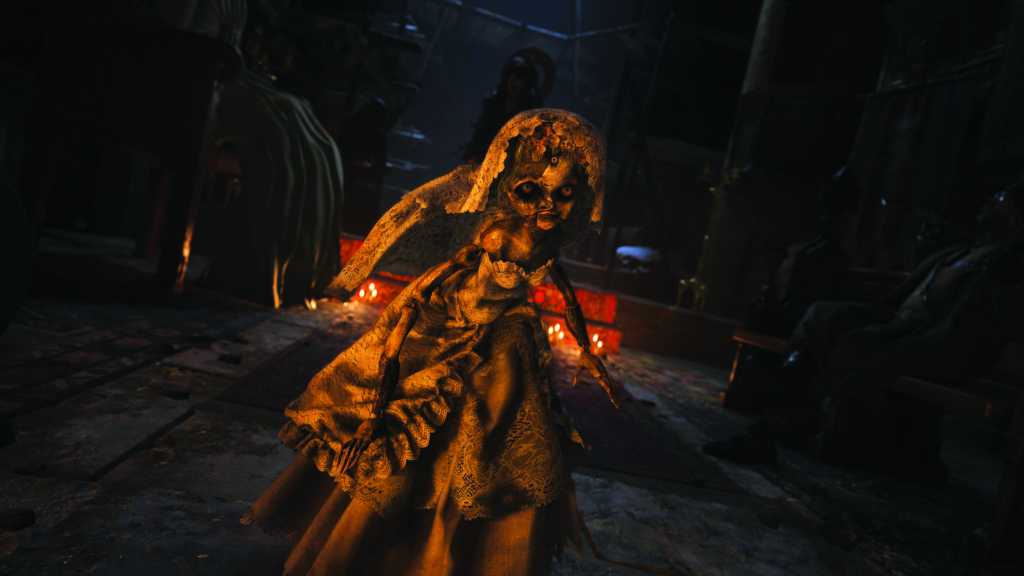Resident Evil Village tries its hardest to appeal to many different kinds of horror gamers and while it succeeds on these attempts not all of them truly capture what makes Resident Evil special. Players start off after the events of the previous mainline game, resuming the role of Ethan Winters as he tries to cope with life after escaping the horrors of the Baker family. Plot happens and you’re tossed into a remote village with a few weapons, loads of enemies to fight, and a strange man who’s willing to sell you guns and ammo as well as cook up any meat you’re able to find.
Just like the previous game it’s set in a claustrophobic first-per-son perspective, a relative novelty to the series. It works well enough, with the tightness of the camera limiting your vision. This has the effect of creating more tension in moment-to-moment gameplay as you’re constantly turning around during com-bat to check on other enemies closing in on you.
I played this game on the PlayStation 5 and it makes great use of the hardware with both visuals and controls. The game looks gorgeous on a 4K screen and while there is slight pop-in noticeable on some of the smaller details it’s largely a smooth graphical show-case. I also noticed a marked improvement in facial animations over the previous game. Some of the animations there were pretty poor for a big release and I’m happy to see them improved. The PS5’s haptic triggers work wonders here, as each gun has more or less resistance when aiming and firing. Some of the larger guns have a heft to them and require quite a bit of force to aim.
What Village did best to grab my attention is offer up a sampler plate of interactive horror, spanning the major sub-genres of horror gaming in a mostly positive way. The game world itself is demarcated into a few different areas and each one has its own unique gameplay style and feel. The first area—a large castle overseen by a tall, buxom woman the internet has grown infatuated with—you encounter contains the most traditional Resident Evil gameplay, with various key items strewn about which unlock access to more areas. Puzzles are strewn about as well which, while taking only a small bit of brain power to solve, are something which has been largely absent from the franchise for the last decade. All the while Lady Dimitrescu stalks the hallways, looking for an Ethan sandwich to snack on. This area stood out to me the most as a return to form which I sorely missed from the franchise.
While the next area did enough to keep me engaged, the last few areas fell somewhat flat in terms of concept and execution. The area immediately following the castle is a mansion constantly twisting and turning in on itself. It deprives you of all means of defense and pits you against one spooky enemy to deal with. This area is much more representative of modern “walking simulator” horror games which have largely dominated the market in the last ten years. The last few areas are much more focused on combat and lost my interest, instead going through the motions like I have in dozens other shooters over the years. There’s an area almost entirely focused on fighting a single, slightly disappointing boss and the last real areas of the game are nearly entirely encounter-based with only a shadow of the first area’s puzzles left. It brings Village to what I’d consider the weakest era of Resident Evil games, more focused on set piece battles than slow-paced combat and puzzle solving. Though these areas are weak from a gameplay viewpoint they’re spectacular from an art design perspective. Giant hooks carry common enemies you’ve been facing the entire game off to unseen destinations. The threat of one of them deciding they want an early lunch and dropping in on you is present throughout, leading to playing the game with a jumpy trigger finger. While I didn’t love the last few large areas of the game, they were still good enough to drive me forward to the game’s conclusion. The game ends with a few set pieces starring a long-time character of the series and the disconnect between Ethan’s more survival-based gameplay and the gung-ho style of these last moments is blatant. You’re supercharged with some of the strongest weapons in the game, as well as a squad of soldiers at your disposal. Tearing through these enemies with ease gives you a last power fantasy before the game’s ten or so hours are up. Despite these issues I enjoyed this horror smorgasbord as a whole and loved some of the directions it took. I just wished it stayed away from the motifs which led to the series’ previous decline.




